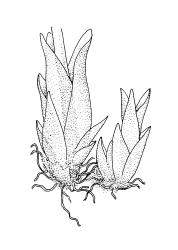Plants minute or small, acrocarpous, with protonema giving rise to linear or spathulate protonemal flaps that may disappear (in Tetraphis) or persist (in Tetrodontium) after the development of gametophores (stems). Shoots well-developed, erect, to c. 15 mm (in Tetraphis) or highly reduced (in Tetrodontium), often terminating in a disc of broadly ovate leaves surrounding a cluster of multicellular and globose gemmae (in Tetraphis). Stem leaves (in Tetraphis) erect-spreading, 3-ranked, ovate and acute, weakly decurrent, entire, costate, becoming gradually narrower and longer acropetally in ♀ shoots or absent (in Tetrodontium); laminal cells firm-walled, smooth, rounded-hexagonal; costa ending below the leaf apex. Gemmae present (in Tetraphis) or absent (in Tetrodontium).
Autoicous. Setae straight, flexuose, or geniculate; capsules erect, ellipsoid or cylindric, exserted; peristome present, of four large, narrowly triangular, unsegmented, and multicellular teeth. Operculum conic. Calyptra mitrate.
The Tetraphidaceae are highly isolated systematically and are assuredly an ancient group. The family is traditionally (Brotherus 1924, p. 344) placed in its own order. More recent authors place them in their own subclass (Crum & Anderson 1981) or their own class (Tetraphidopsida; Goffinet et al. 2009). The members of this family are unique by having four narrowly triangular peristome teeth, which are not jointed and are composed of intact but dead cells (nematodontous).
Crum & Anderson (1981) describe the protonemal flaps as "leaflike brood bodies". They illustrate (their fig. 617, E, for Tetraphis pellucida) the multicellular gemmae as borne on a filamentous stalk.
The family consists of two genera. Tetraphis is circumboreal in distribution and contains two species, one of which (T. pellucida) is characteristic of rotten logs and stumps in coniferous forests throughout the northern hemisphere.
| Category | Number |
|---|---|
| Indigenous (Non-endemic) | 1 |
| Total | 1 |




